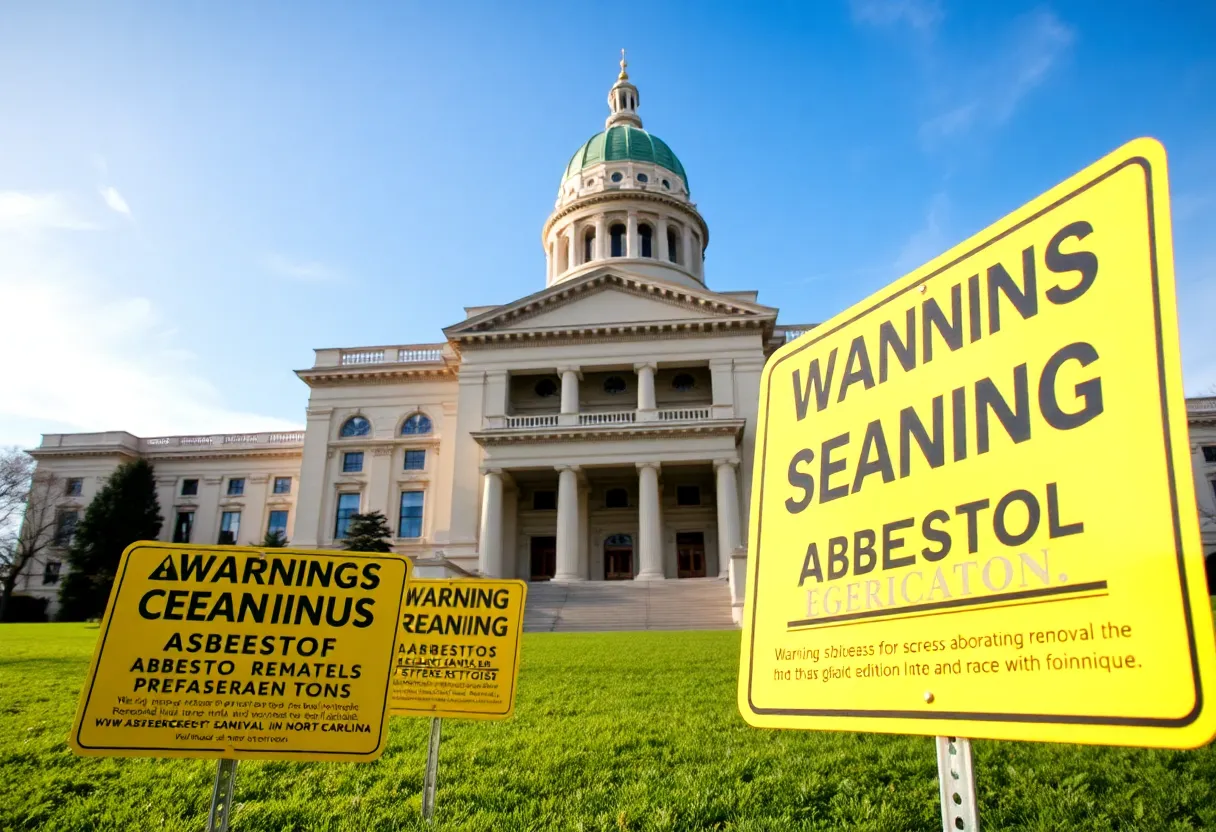News Summary
Asbestos removal at North Carolina legislature began without notice, raising safety concerns among lawmakers and the public, especially for schoolchildren.
The Shocking Discovery of Asbestos Removal at the North Carolina Legislature
In a startling revelation, asbestos removal operations at the North Carolina state legislature commenced without prior notification, raising safety concerns among lawmakers and the general public. Representative Maria Cervania stumbled upon warning signs and tape barring access to her office hallway, leading to alarming questions regarding the safety of both lawmakers and visitors, particularly vulnerable schoolchildren who frequent the area.
Asbestos: A Long-standing Hazard
The North Carolina legislative building, boasting over six decades of history, was constructed with asbestos due to its fire-resistant properties. Yet, this decision has contributed to serious health concerns, as studies consistently show that exposure to asbestos can trigger various types of cancer, including mesothelioma—a rare and deadly cancer. The lack of communication regarding the ongoing removal has left many in the community feeling uneasy about their safety.
A Long-term Renovation Endeavor
The current asbestos removal is part of a broader, long-term renovation strategy that often dovetails with other essential building repairs. While some officials, including Senate Leader Phil Berger, have brushed off concerns regarding the removal process, the overall sentiment among local representatives remains one of trepidation. Cervania emphasized the importance of ensuring the well-being of all who enter the legislative grounds, expressing the need for heightened awareness and transparency surrounding such hazardous operations.
Controversy Surrounds Safety Measures
In an email from Legislative Services Officer Paul Coble, the representative learned that the ongoing work is scheduled during nighttime and weekends to limit daytime disruptions. Coble confidently asserted that there is no risk to anyone present in the building during the removal process, citing oversight from trusted vendors and the Department of Health and Human Services (DHHS). However, concerns linger over the adequacy of monitoring equipment and the potential for asbestos fibers to persist in the ambient air of the building long after the removal is completed.
Warning Signs Uproar
Though warning signs indicate the ongoing removal efforts, they are often taken down during daylight hours when foot traffic surges, further exacerbating worries about unknowing exposure. The absence of the term “asbestos” in Coble’s correspondence left many scratching their heads about the real dangers lurking in the vintage halls of their state government.
A Legislative Response from Michigan
Meanwhile, across state lines, Michigan lawmakers are gearing up to introduce new legislation aimed at addressing the critical issue of asbestos safety. In response to troubling investigations that revealed inadequate enforcement of workplace safety laws, representatives from Michigan are preparing a legislative package that seeks to hold contractors accountable for maintaining safe asbestos removal practices.
Stricter Penalties on the Horizon
With State Representative Stephanie Chang leading the charge, proposed legislation will implement stricter penalties for safety violations and mandate annual reports on asbestos inspections by the Department of Environmental Quality (DEQ). Past investigations have uncovered glaring issues with contractor compliance, revealing that the Michigan Occupational Safety and Health Administration (MIOSHA) rarely imposed severe penalties for violations related to asbestos management. Thorough findings indicated that many demolition contractors mishandled asbestos safety protocols, leading to significant public health concerns.
The Urban Crisis of Asbestos
Detroit’s struggle with unsafe demolition practices has further underscored the urgent need for reform. The DEQ uncovered considerable violations linked to improper asbestos handling, resulting in suspension for contractors with a history of negligence. The city’s inadequate oversight during these operations raised alarms about serious safety hazards, prompting lawmakers to emphasize increased accountability and transparency in practices related to asbestos removal.
Final Thoughts
The issues unearthed in both North Carolina and Michigan highlight a pressing need for better safety protocols and communication concerning asbestos handling. As public concern grows, it is evident that lawmakers and contractors must prioritize the health and safety of citizens, advocating for immediate reforms in the approach to asbestos management in all states.
Deeper Dive: News & Info About This Topic
HERE Resources
Rising Concerns: Asbestos Exposure Linked to Mesothelioma in High-Profile Lawsuit
The Bronx Community Faces Uncertainty After Five-Alarm Fire
Ex-Nurse Battles Mesothelioma: A Story of Asbestos Exposure
Legal Battle Sparks Over Asbestos Litigation Amid Health Violations
The Persistent Battle Against Malignant Mesothelioma: Maintenance Therapy Explored
Delay in Peterborough Regional Swimming Pool Demolition Due to Asbestos
Illegal Asbestos Dumping Shocks Outwell Residents
UK Parliament Faces Urgent Asbestos and Fire Safety Crisis
Tragic Loss of Former British Rail Worker Linked to Asbestos Exposure
Massive Fire Devastates Bronx Businesses: Asbestos Concerns Rise



















